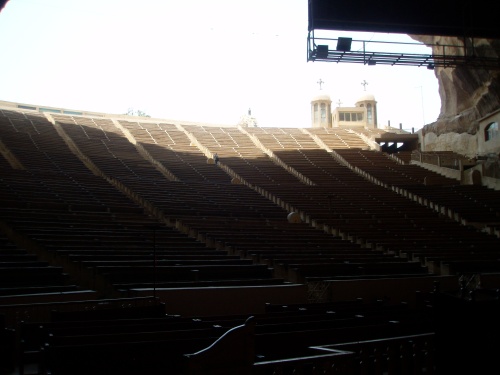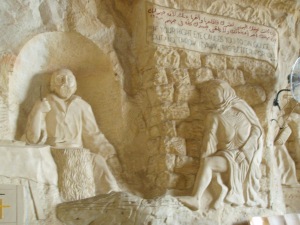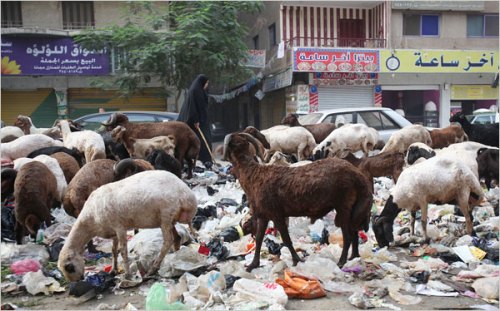Sorry, people. It’s been an odd couple of weeks.
I confess, I feel a little odd writing this in American environs. A blog about an amateur orientalist’s adventures in Egypt – and misadventures teaching – should best be written by the one in the field. Otherwise, it ends up becoming a mirror for memory, and though I’m all about that, I’m not sure this blog should be about that.
Fear not, gentle readers, I do have a number of things to share with you, however. And this duck’s not about to stop writing anytime soon.
Zabaleen. Wow.
It’s not for the faint of heart. After reading a few articles online, I made up my mind to go, if only for the reason that I’d regret it enormously afterwards.
Interesting cab ride
I’ve written on-and-off about Medinat al-Zabaliyya for the past few months – it’s been a source of continuous fascination for me since I arrived, and it’s perhaps a little appropriate that it should be the last thing I visit.
I left around noon from Midan Falaky, catching a white cab that had AC, and about halfway through the ride, the driver (a large-ish man named Abdul-Rahman) started up with the usual friendly chit-chat (You speak Arabic well, what’s your name, etc. etc.). I’ve gotten particularly evasive with the nationality question and usually duck it with shopowners by telling them to guess where they think I’m from. Most common answer: Germany. It’s obviously the blonde hair, but that usually gives me a chance to tell them that my grandmother would get mad (she’s of Polish stock).
I explain this because I usually find this kind of banter back-and forth usually quite useful. I’ve found that Egyptians tend to bristle or become less receptive to conversation (or bargaining) when approached in a no-nonsense manner. They clam up, and if you attempt levity, pleasantries work wonders. I suppose the same is pretty much true stateside, but in Egypt, it’s triply so. It’s not uncommon to be offered tea, no frills, no strings attached. It’s just the hospitality gene kicking in.
In fact, Tammam once made a few suggestions for bargaining in the souk that I’ve taken to particular heart: among them, the recommendation to smile and laugh and try to joke has been the most helpful. Once you get someone joking, things tend to move a little quicker, a little smoother than you would expect. Ask about their family, their children – you’ll get pictures and they’ll want to see yours. People want to know where you’re going, where you’re coming from, and although I’ve found this occasionally annoying, I’ve used it far too much myself to get to know people better. It doesn’t really pay to get irritated at these things; rather, if you work with it, I think the culture has its own rewards.
I digress.
The point of bantering really relaxes things and allows the car ride to go a little faster – even knock down the fare a bit (in a black cab), or at least avoid the shouting match at the end of the ride. Things were going rather well until we got to the part where I actually say, “No, my name is Michael, and I’m a teacher, and American.”
“I hate Americans.”
No joke. Guy really said it. Expression changed, face fell, the works. Smile turned to dust.
“Really?”
Yep. He hated them.
Actually, what my recent acquaintance really hated were the Zionist establishments that America perpetuated (his words, not mine). Abdul-Rahman proceeded to lecture me for the next twenty minutes about how Americans had a corrupt government that was (obviously) headed by the Jews and an international Jewish conspiracy, and by they way, you’re not Jewish, are you?
Anti-Semitism lives, people.
At the end of this, I pointed out something.
“Do you like Hosni Mubarak?”
“What?”
“I mean, do you think Mubarak is a good president? That there’s no corruption in the present government?”
“Of course there’s corruption.”
“So is it fair if I assume that you’re a thief if your president is ibn siteen kalb (the son of sixty dogs, but for colloquial purposes, let’s say son of a bitch)?
He laughed.
“No, of course not. There’s a big difference between governments and people.”
“Well, Mister Abdul-Rahman, a suggestion: don’t think that I’m a bastard just because you think my government’s a7a (absolute shit).”
He laughed, and the matter was closed. He even knocked down the fare on the meter at the end.
I’ll have more to say on Zionism, soon: I’ve been working on a post about it at the behest of my students.
The City of Garbage
The district of Zabaliyya is just at the foot of Muqattam: you ask for awal Mu5attam to get there. You wind your way around the old Ayyubid and Fatimid walls, get a pretty sweeping view of the southern City of the Dead, and plunge headlong into the blistering heat of the highway, above which hovers the giant magnifying glass of dust that turns the sky into the gray of hot metal.
You smell it before you see it.
It’s that sickeningly sweet smell: the acrid stench of burning garbage, smoky and dry , yet soaked with organic matter and decay. It feels hot and cool, and it’s worst in the streets you wind through, which haven’t yet dried on account of the alleyway shadows keeping the sun out and the roads still wet.
Entrance is through a large gate that proclaims the area name and the “company” that runs it, and the district itself has very much the feel of a village. Streets are narrow, not from the buildings being close together, but the garbage being stacked up in giant piles, compressed and bundled together in large plastic sheets. Trucks are coming and going, and there are people everywhere.
Men in tattoos go sleeveless, shirtless, some dressed normally, but with a single sleeve up. They show sometimes remarkable ink art – but mainly crude executions of Jesus, the Blessed Mother, or crosses. Graffiti, like everywhere in Egypt, abounds – but it takes you a moment to understand why it’s strange: because there are no spray painted “No god but God and Muhammad is his Messenger,” no stylized “Allahs” written in all manner of calligraphy, no “BismilLah ma sha5 Allah” (In the Name of God, What God Wills, a common phrase written above doorposts against the Evil Eye). Instead, you have Biblical injunctions, often with well-translated equivalents in English or French, but mainly just the Arabic for:
I can do anything through Him who strengthens me.
Have mercy on Your Children, oh Lord!
Pray for us, Blessed Virgin Mother.
Christ is Risen!
Abdul-Rahman takes the third alley to the right, which is a way down, and the monastery of St. Simon the Tanner announces itself through a large, colorful sign on the corner. We work our way up the hill. The cab stalls, and we rollick backwards, almost into a house, but start up again. Abdul-Rahman is a glob of curses as we inch up the hill, which is a little steep.
And suddenly, green.
Trees and gardens and the clean desert walls of sandstone. We are against the hills of the outer city. We climb up, stop at the gates, and the guard takes one look at me, and waves us on.

Stadium seats for Jesus! A view from the largest church at altar-level. Seats thirty thousand. Masses every week.
A Short Catechism

I don't buy this story: while excavating the present-day church, workers uncovered the "miraculous" carving of the Blessed Mother and Jesus. Adl (and apparently the monks) claim it has never been touched by human hands except to clean it. I'm not biting, but mainly because I like my miracles approved by Papal investigations and Vatican councils -- it's the Catholic in me.
The monastery isn’t as nearly as old as you want it to be, but the legends surrounding it date back years.

Meet the saint. According to Adl, he was entirely decomposed -- except for the face, which was perfectly intact.
Named for St. Simon the Tanner (or the Shoemaker, which tends to be the more affectionate name) the site of the current construction dates back to the original saint himself, who lived in and around Muqattam as a hermit, fixing shoes for support himself. Local lore has it that when a not unattractive young Copt came to have her shoes fixed, she hiked up her skirts a little too high (Adl said it was up to her thighs) in the process of removing her sandals. Naturally, the saint was scandalized, and (like any good monk), promptly went and plucked his right eye out. (Recall, if you will, the scriptural injunction of Matthew 5:29 that “If thy right eye scandalize thee, pluck it out and cast it from thee. For it is expedient for thee that one of thy members should perish, rather than that thy whole body be cast into hell”). A bit much.

Simon the Shoemaker and the woman who would lead him astray. Note the captions carved in English as well. It struck me as a little pandering to the wandering aganab.

The most neatly organized garbage you've ever seen. I swear, it's more organized (though not necessarily cleaner!) than most places in Egypt.
I was shown around by a gallabiyya-clad, portly fellow named Adl, who spoke incredibly clearly for using so many religious terms. He also liked to exclaim “Hallelujah!” at random points in his story, and cross himself rather excessively. But he made for a good story-teller.
The main church of Simon the Tanner is enormous: it has claims to being the largest church in the Middle East (hard to believe) and regularly seats over twenty thousand. The relics of the saint are placed just to the right of the altar-screen, and rock carvings (actually quite tasteful) abound above and below and everywhere of the miracles of the Mountain and the story of the Resurrection of Christ.
Visit the well-written website (!) here: http://cavechurch.com/home/index.asp
No, seriously, visit it.
There’s a great section about how Muqattam (which translates roughly as “cut up” or “broken”) got its name: the Copts claim it was due to a tenth-century miracle worked out by the dynamic duo of the Coptic Pope and the ancient saint at the challenge of the then-current wacky caliph. Copts believe that Simon the Tanner literally “moved the mountain” from the center of the city, dribbled it (like, bounced it up and down so that the sun was visible from underneath it), and dropped it where it is presently. No joke.

One of the awesomely-underground cave-churches in the side of the mountain. No shoes, and odd seating.
Thanks to a growing congregation, additional side-churches have been carved into the rock surrounding, totaling in five churches and a few monastic little chapels. Some are completely underground.
But talk about contrast.
You walk out of the monastery gates, and the clean, but dusty environs of the well-funded cloister contrasts sharply with the mess of Zabaliyya. It’s dirty, but not disorganized. Remarkably. And there are strange aspects: like walls build out of crates, streets made not out of gravel, but crushed green glass, and people going barefoot. Actually, I was also surprised to see all the gold: I mean there was bling like whoa. Women had giant medals of Jesus (big, gaudy, gansta-type medals) from thick chains, and men wore big gold rings (I should point out that the wearing of jewelry by men — for the most part – especially of gold jewelry, is largely considered haram by most Muslims). And there were quite a few dolled-up girls, hair hanging out everywhere. But largely, the amount of gold was shocking, even on the people that looked like they were working.
And man, I have never been more self-conscious about having a camera in my life. How do you take pictures of that? Do we go to garbage dumps in the US and take pictures? Who would want a picture of that?
Part of me is outraged by my own tourist-ness. It’s deliberately making poverty into a kind of bohemian Disneyland. These people are obviously struggling, and if I were in their position, I would have dashed my camera to pieces and slapped my ass. But that doesn’t take away from the fact that, from the outside, the picture and place is still fascinating. It’s the same kind of argument that was posed against the producers of Slumdog Millionaire: you can’t just use poverty to your own artistic or cultural ends. But how do you raise awareness, combat poverty, make other people feel for it? They should already feel for it, but they don’t.
….
I’m a little disgusted at the end of the day, but not necessarily by the quarter. It’s not the stink of the district that makes me more than a little nauseous. It’s the realization that wanted to see something like what I’ve seen, and now that I’ve seen it, I’m walking out. I can’t really describe it as guilt, it’s not pity even: it’s more like heartbreak..
Heartbreak. Even now, weeks later, the cracks are still there.


 Briefly: in contemporary usage, “Copt” usually refers to an ethnic group of Egyptians that claims non-Arab ancestry (i.e., they are descended from the ancient Egyptians, not from the Arabs), and have been traditionally members of the Coptic Orthodox Church of Alexandria– by some accounts the oldest sect of Christianity in existence (founded 42 AD in Egypt by St. Mark of Gospel fame). The word Copt is also linked to the classical fus-ha Arabic word for
Briefly: in contemporary usage, “Copt” usually refers to an ethnic group of Egyptians that claims non-Arab ancestry (i.e., they are descended from the ancient Egyptians, not from the Arabs), and have been traditionally members of the Coptic Orthodox Church of Alexandria– by some accounts the oldest sect of Christianity in existence (founded 42 AD in Egypt by St. Mark of Gospel fame). The word Copt is also linked to the classical fus-ha Arabic word for 

